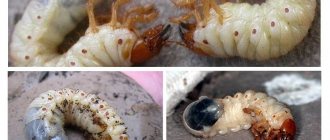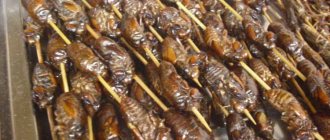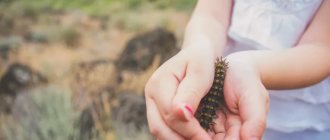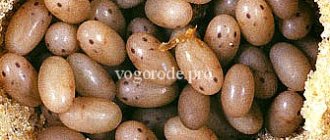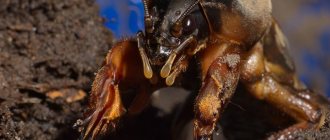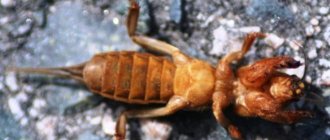The scary and menacing appearance of the mole cricket multiplies rumors and misconceptions. It can be assumed that this insect must bite painfully. But in fact, the cabbage weed physically cannot bite anyone. The structure of its mouthparts is such that it is not able to bite through human skin: nature has ideally adapted this insect for digging underground passages and absorbing plant food. It lacks a sting and glands that produce poison. Let's leave the aesthetic side alone, because some people even like spiders and cockroaches. But the bear still gives some unpleasant sensations to those who grab it with an unprotected hand.
Why do people think mole crickets bite?
The main reason is the scary view. People believe that if an insect has such a menacing appearance, then it is for a reason. Moreover, many say that they themselves felt a mole cricket bite - and it was painful.
Gardeners believe that a mole cricket can bite a person because:
- she has a large mouth with powerful jaws;
- when she is picked up, she tries to escape, including by biting.
You can find stories about how poorly people feel after allegedly being bitten by a mole cricket. In the list of symptoms:
- nausea and vomiting;
- elevated temperature;
- redness and soreness in the wound area;
- weakness, lethargy;
- headache and so on.
How to get rid of a mole cricket
Chemical and biological drugs
Modern chemical pest control agents can be divided into 2 groups: preparations based on imidacloprid and those based on diazinon .
Imidacloprid affects the nervous system of the pest, causing paralysis and convulsions. Diazinon blocks breathing and poisons the mole cricket. Insects die when they come to the surface of the earth.
Thunder
Bait preparation in the form of granules. The food additives included in its composition attract mole crickets more than plants. 2–3 g of the product are placed in the holes and passages of the pest to a depth of 3–5 cm with an interval between granules of 0.5–1 m. The depressions are covered with earth, compacted, and if the soil is dry, then moisten it. Use the drug 5–10 days before sowing seeds or planting seedlings. The protective effect lasts 2 weeks.
Medvetox
Available in the form of large red granules. Protects the root system of seedlings and adult plants. In the evening, the granules are laid out in holes and grooves to a depth of 3–5 cm, covered with earth and watered. To block the paths, it is recommended to distribute the drug along the perimeter of the beds. The consumption rate of the product is 30 g per 10 square meters. m.
1 granule kills 1 pest. The granules do not dissolve in the soil and protect for 3 weeks. The product is safe for earthworms. It is applied no later than 2 months before harvest.
Frontier
The drug protects for 2 weeks and does not cause addiction to the active substances. Causes the death of the pest within 3 hours after eating. The consumption rate of the product is 30 g per 10 square meters. m. Apply several days in advance or on the day of planting. Planting depth is 3–5 cm; if necessary, moisten the soil.
Phenaxin plus
Bait in the form of granules. It has a pleasant taste and smell for mole crickets. The granules are laid out both in the places where plants are placed (10 days before planting) and near manure and compost heaps.
Make furrows 2–3 cm deep in the soil, place 3–5 granules, sprinkle with earth and spill. An interval of 0.5–1 m is maintained between placement sites. The drug protects against pests for 14–20 days.
Grizzly
Destroys adults and larvae within 48 hours after treatment. The bait is introduced into the holes to a depth of 2–5 cm, 2 g per 1 square meter. m, departing from the plantings by 5–10 cm. Apply the drug in the morning or evening at an air temperature no higher than 25°C.
Boverin
A biological product based on a natural fungus isolated from soil. It is planted in the ground in wet weather, in spring or autumn. In order for the fungus to take root and begin to grow, it will need to be applied annually for 2–4 years.
The spores of the fungus, once on the pest, penetrate it and, growing inside, cause the death of the mole cricket. The dosage of the product is 400–500 ml per 10 liters of water.
Nemabact
A non-toxic biological product based on nematodes and bacteria that are dangerous to the pest. Use at air temperatures between 10–26°C and high humidity. To activate the nematodes, the drug must warm up naturally for 4–8 hours.
The product is diluted in water at a concentration of 1:100 and watered the soil. The solution should not get on the leaves; the nematode will die on them.
Traditional methods
Many summer residents “hunt” mole crickets by setting up non-chemical baits and traps .
- In autumn, the pest is caught in manure pits . They are dug to a depth of 0.5 m, filled with fresh manure and covered with earth. Pests will gather in these attractive wintering places. After the soil freezes, the manure is scattered and the mole crickets die from frost. Manure baits can be placed in May, when the pest lays eggs. After a month, the traps are checked and the adults and eggs are destroyed.
- The pest has a strong sense of smell and is caught by smell . In their habitats, mole crickets bury 0.5 liter glass jars or plastic bottles with the neck cut off, level with the soil. Porridge is made from corn, oats, peas, and wheat, aromatic vegetable oil is added and jars are filled. Additionally, karbofos and zinc phosphide are added to speed up the death of the mole cricket. Such traps should not be left unattended, as pets may be harmed.
- You can make safe baits. Insects love fermented beer and use it instead of porridge, pouring it into buried bottles and cans.
- to crushed eggshells from fresh eggs and placed in the pest’s burrows.
- The smell of kerosene repels mole crickets . Sand moistened with kerosene is scattered around the beds where the presence of mole crickets is noticed.
So is mole cricket dangerous for humans?
No. All these stories in reality are either an ordinary phobia (like many others - with spiders and other harmless insects), or a figment of the imagination of too suspicious people who held cabbage in their hands. It may also be a coincidence of a truly painful condition caused by an infectious or other factor coinciding with the incident of grasping an insect with the hand.
Indeed, the mole cricket will violently break free if you grab it. But what is perceived as a bite is actually scratching or pinching the skin with its serrated front paws. Yes, objectively this is not the most pleasant feeling. But she will not be able to destroy the integrity of the skin with these paws, and even more so with her gnawing device. But the mole cricket is harmful in a completely different way - by damaging and destroying the root system of vegetable and berry crops, and by eating root crops. Just two adult individuals are capable of destroying six acres or even more in one season.
Harmful activities of insects
How dangerous a mole cricket is for humans, if it does not threaten health, is very interesting. Gardeners, market gardeners, and owners of summer cottages deal with it. Pest is associated with the feeding habits, behavior, and life cycle of the insect.
The harm of the mole cricket The mole cricket lives underground. Digs numerous tunnels and holes. Their depth reaches 50 cm. In the process of building a nest, it damages the root system of plants. Crops dry out, become sick, and die. The insect is especially dangerous for seedlings.
The mole cricket feeds on roots, ground parts of plants, and root crops that are in the ground. In the garden it poses a danger to almost all crops.
Can a mole cricket bite?
The claim that a top can bite a person is false. To do this, it is enough to examine the insect’s head with magnification. The first thing that catches your eye is the jaw. The photo shows that in addition to the large jaws of the oral apparatus, a pair of tentacles are attached, with the help of which the mole cricket finds and holds food. By the way, this insect eats not only roots and roots - the cabbage plant’s diet also includes small insects, in particular earthworms or even its young.
But the density of the human epidermis cannot be compared with the shell of worms or young larvae that are not encased in chitin. Only an insect with a piercing-sucking mouthpart can damage human skin. These include harmless-looking mosquitoes, less harmless wasps and other stinging insects, and a very inconspicuous, but extremely dangerous tick that carries serious diseases. Medvedka is not given this - and what good does she need it if her blood, like food, is not interested in her.
What do they eat
Mole crickets are omnivores, feeding on roots, tubers, rhizomes, insects, earthworms, and other invertebrates. Leave neat round holes in tuberous plants.
Sometimes they leave their burrows at night to get leaves and stems, which they drag underground before consumption.
The mole cricket feeds on a wide range of crops and disturbs the soil with its burrows. It is considered a harmful organism because it damages grains, legumes, perennial grasses, potatoes, vegetables, beets, sunflowers, tobacco, hemp, flax, and strawberries. Damages the roots of grapevines and fruit trees.
The pest causes damage to wheat, barley, oats, rice, corn, and sugar beets.
When there really is danger
A mole cricket can be dangerous not only for agricultural and other plants only in cases where it eats poison, remains on the surface of the ground and someone feasts on it. It could be a starling or another bird, a mole, or an overly curious dog with a habit of grabbing everything in its mouth. These same living creatures can grab not only the cabbage plant, but also the poison itself, if the poisonous bait has attracted their attention. Then manifestations of intoxication are all the more possible.
If you have not taken care of your pet, you need to take it to the veterinary clinic as soon as possible. It is quite possible that the culprit is not a mole cricket, but, for example, a poisoned mouse or rat. Then the danger is really serious, since coumarins, substances that prevent blood clotting, are used to bait rodents.
A gardener who tinkers in the ground should not be afraid of a mole cricket bite, but of other much more serious threats. It is impossible to suffer from the poison of the cabbage plant - it has no poisonous glands. But if you treat your area with pesticides without following safety precautions, you can easily get poisoned. And if on the same day you picked up a bear in your hand, you can link this with your poor health.
The greatest danger lies in the ground. The soil can harbor the causative agent of tetanus and other dangerous diseases. Therefore, a person who constantly works on a plot of land and comes into contact with organic fertilizers (compost, manure) must be vaccinated against tetanus. With the slightest damage to the skin, tetanus toxin enters the bloodstream and begins to affect the nervous system. If the ingestion of the tetanus bacillus coincides with the capture of a mole cricket, a person may subsequently not pay due attention to his condition. And for tetanus, the sooner the vaccine (tetanus toxoid) is administered, the more favorable the patient’s prognosis.
Natural enemies
Natural enemies:
- rooks;
- starlings, other birds;
- shrews;
- moles;
- ants;
- ground beetles;
- nematodes;
- ticks.
If there is a thaw in the winter, fungal diseases cause mass death.
In addition to birds, toads, and insectivorous mammals, predators of mole crickets include underground killer bugs, wolf spiders, and various beetles. The South American nematode Steinernema scapterisci kills the Neocapteriscus mole cricket by introducing bacteria into its body, causing an infection.
Parasitoid wasps of the genus Larra lay eggs on the external surface of the pest, and the wasp larva develops on the outside. Ormia depleta is a specialized parasitoid, the fly larvae hatch from eggs inside the abdomen.
The fly is attracted by the cry of the male mole cricket, and it lays a larva on him. Predatory beetles of China and Japan - bombardier beetle Stenaptinus jessoensis. The adult beetle lays eggs near the pest's burrows; its larvae enter the egg chamber and eat them.
Is Medvedka useful?
There can be no definite answer: everything in living nature is interconnected, and if you completely destroy the population of any creature, the food chain will be interrupted and problems will begin. The benefits of mole crickets are talked about by mentioning its ability to loosen the ground and, thus, improve the structure of the soil. But all this looks somewhat doubtful if we take into account that it will not be possible to grow anything in this loosened soil - this wonderful ripper will immediately eat everything.
Another point is the supposed healing properties of dried mole crickets in the fight against tuberculosis. Official medicine has no evidence of such an effect. For fishing, it is used as live bait only for large fish due to the size of the insect and durable chitin.
What does it look like
Mole crickets vary in size and appearance. Most are moderate in size for an insect. Adapted for underground life, they have a cylindrical shape. Body length ranges from 20 to 45 millimeters.
The color is dark brown with a silky tint, yellowish underside. The body is covered with thin velvety hairs. The front legs are powerful, modified for digging.
The hind limbs are adapted for pushing the ground, rarely for jumping. The elytra make up half the length of the abdomen, the wings are transparent, reticulated with veins.
They are folded and are rarely used, since the mole cricket usually remains underground. Males are distinguished from females by an area of exposed veins on the forewing known as the "harp". On the head are two filamentous antennas and a pair of eyes.
Adult mole crickets of most species can fly, but do so infrequently. They come to the surface, fly in the evenings and at night, and are attracted to light sources.
Gryllotalpidae are a monophyletic group of the order Orthoptera ( grasshoppers , locusts, crickets). Females lack the external ovipositor that other crickets possess.
Ways to deal with mole crickets
There are many ways to deal with mole crickets, but you won’t be able to get rid of it quickly. First you need to try traditional methods, only after that turn to chemicals. The video will help in the fight against such insects; mole crickets are difficult to remove, so gardeners share methods. It should be taken into account that methods that are effective in one area may not produce results in another.
Traditional methods of getting rid of insects
- Frequently loosen and dig up the soil; if nests are found, destroy them and cover them with washing powder. In this way, you can destroy several hundred of them, but it is unlikely that you will be able to overcome them completely.
- In the summer, it is necessary to dig out small furrows and instill poison there. If the insects get to these places, they will be poisoned, but there is no guarantee.
- Many gardeners use a simple but effective method: in the fall, dig a small hole and bury manure in it, and when frost sets in, prepare a chemical poison, dig a ditch and fill it. With the onset of cold weather, all the mole crickets will gather in this warm place.
- By spring, you can collect eggshells, grind them into powder and sprinkle the resulting substance into each hole before planting. You need to know what the mole cricket insect eats, and accordingly, add it there.
- Pouring a soap solution into the burrows also has a good effect. Insects and their larvae quickly die from soap. Then you will need to collect all the nests with a shovel and take them away from the garden. If you miss even one nest or fail to destroy the female, the mole cricket will again take over your area. But remember that soap or washing powder can harm not only insects, but also the plants you grow.
- Some people practice planting crops with a pungent odor around the perimeter of the site and between beds of other crops. It could be garlic, mint, wormwood. Spicy-smelling leftover food products are also laid out: herring tails, spiced sprat, herring. But the effectiveness of this method is questionable, because this way you will scare away the mole cricket, but perhaps attract other pests, insects or animals.
If folk remedies do not help, then you need to use chemical ones, but such a struggle will be long. The most effective are “Antonem-F” and “Nemobakt”, which can get rid of 90% of adults and 80% of larvae.
One can talk for a long time about the benefits and harms of the mole cricket; on the one hand, it destroys the crop, and on the other, it fights other harmful insects. But getting rid of this insect is extremely difficult, and this is a fact.
Distribution and habitat
The habitat where representatives of this type of pest are found covers a very large territory: Western Europe, except for cold countries such as Norway, Asia - Central and Southeast, Transcaucasia and North African countries - Egypt, Morocco, Libya and others. In Russia, the insect is distributed everywhere - from St. Petersburg to Crimea.
The mole cricket does not like hot and dry places, so they live in the part where there is moisture, that is, near reservoirs in sandy or clay soils. The most preferable place for them is a place rich in humus, so very often the insect lives in vegetable gardens, orchards and flower beds. They love wetlands and areas with groundwater.
First, the pest settles in damp and well-manured areas of the garden, and later, if it is not destroyed, it will spread to other areas.
What danger does mole cricket pose to the garden?
Having moved into my house from a rented apartment, I happily began cultivating a vegetable garden. Planting onions and sowing carrots made me happy, I was already looking forward to the finished harvest. I decided to sow carrots not like my mother, by the handful, but in a different way, to increase the yield. I took paper tape, spread it with starch paste, then glued the seeds at a distance of 0.5 cm. I sprinkled the tape with only a little earth. And I was incredibly surprised to see a week later that the earth along the entire length of the belt had been dug up.
My surprise knew no bounds; I had never seen anything like this before. It turns out that the mole cricket happily ate the sprouted carrots and snacked on the starch paste! This individual eats everything, bites off the roots of young cucumbers and especially loves young shoots of watermelons, practically dragging them into holes with it.
After the insect, only the flaccid remains of the once living shoot remain.
Yes! Burrows! This insect also digs huge tunnels that collapse, collapsing the garden bed as soon as you start watering the soil. As a result, in the first year, half of what the mole cricket did not have time to eat was dug up and collapsed, and grew small, and even clumsy.

